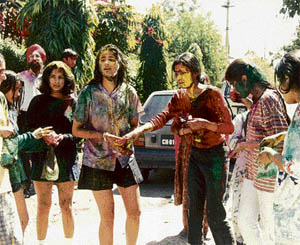|
TELEVISTA
Highs and lows of Holi
Amita Malik
|

Amita Malik
|
Indian
festivals are
colourful and joyous, but they can be dangerous. Holi last week
has left its trail of car and other accidents arising from
people getting inebriated as part of the celebrations. Divali
has its share of children getting injured with fireworks. Even
visits to temples can become dangerous when panic leads to
stampedes. But all this does not prevent people of this
festival-happy nation from enjoying themselves. For the poor, in
particular, it is an occasion to have fun without getting out of
pocket. Radio and television channels find festivals a
heaven-sent opportunity to break the monotony of news, films and
sport.

Youngsters seldom take precautions while celebrating festivals... be it Holi or Divali |
Let us not
forget politics. L.K. Advani visiting Sonia Gandhi with his wife
to offer Holi greetings made the best of both worlds. As usual,
Lalu Prasad Yadav was in his element in his home town Patna,
getting smeared and smearing everyone in sight, and even
indulging in the ancient Holi sport of kapra phaar
(tearing the clothes). Again, how we enjoyed the sight of women
of Mathura beating up their men in their annual moment of
freedom. It was near enough to International Women's Day to make
a point.
But as I said,
festivals can be dangerous and, as usual, it was young men
driving cars, in one instance a young man driving his
grandmother to a temple, who lost their lives tragically. Both
newspapers and TV screens gave us our fill of horror
photographs, showing the mangled remains of cars and
three-wheelers. One would like these horrific visuals to give a
lesson to people to avoid driving while under the influence of
liquor. But it usually is a case of "I am quite
sober", like that advertisement we see on the screen; the
other famous last words being: "It happens to others but
not to me".
So our Holi
weekend on the media became, as usual, a mixture of joy and
sorrow. Crime of passion also dominated the week's viewing. A
young man in Bangalore, a talented Infosys employee, suspecting
his wife of infidelity, smothered her to death and then hung
himself. The Scarlett Keeling affair continues to drag on with
unending twists and turns. Was there nothing, really nothing to
catch our interest for healthier reasons?
For this
columnist, and I dare say to all of my generation and film buffs
of all generations, the long documentary on actress Merle
Oberon, made by Australian television with inputs from other
networks, made for fascinating viewing. I mentioned my
generation because it was well known to us at the time that
Merle Oberon was really Queenie Thomson, born an illegitimate
child to a Chinese mother, who had her roots very much in India,
notably Kolkata and Mumbai, and her pretensions of being a
Tasmanian fooled nobody except herself.
There was, for
instance, her uncle in Mumbai, proudly telling his neighbours
that Queenie was really his niece. Her sexy slanting eyes, a
large part of her stunning beauty, was a part of her Chinese
mother's heritage. But as we followed the extraordinary story of
her life, from humble beginnings to top stardom, much of it
connected with India, including her early stint in Kolkata as
Queenie Thomson, we could at least take pride in the fact that
she originated in India, even if her film, Bhowani Junction,was
one of her least successful ones.
The last irony was how, to
prove her antecedents, she made a cursory visit to Tasmania at
the fag-end of her life to show her mythical origin there, and
how it simply did not work, because no one remembered her.

|